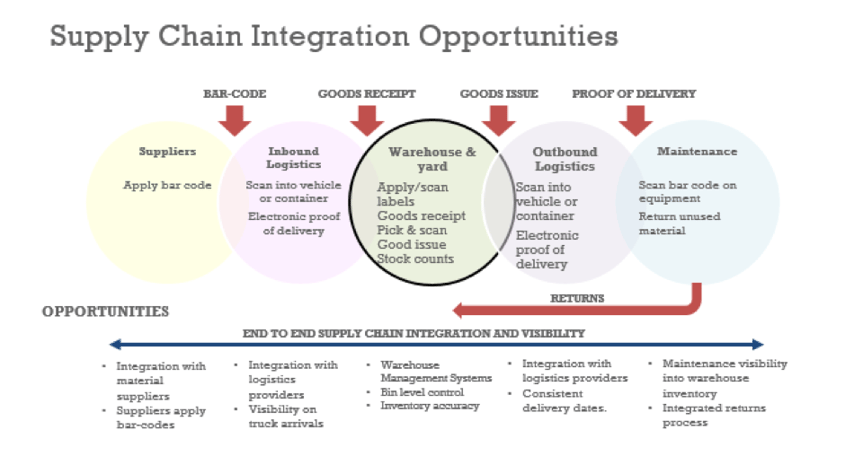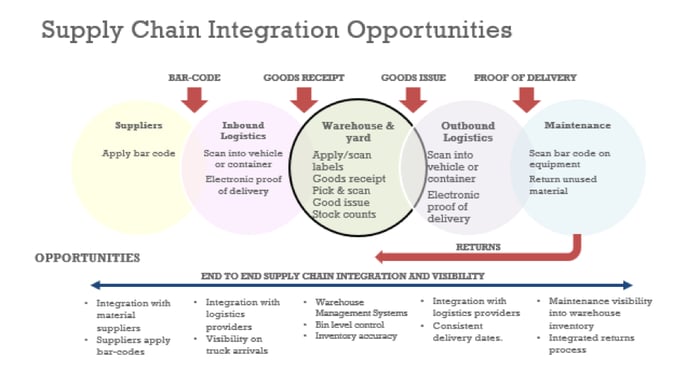Are your supply chain processes paper-based? Do materials arrive from suppliers without bar-codes? Is it more than 5 years since you updated your warehouse systems? If you have answered yes to any of these questions then your supply chain may need attention!
You’re certainly not alone, many industry supply chains remain fragmented, inefficient and make only limited use of technology. A supply chain with limited integration with suppliers and customers with outdated technology will be generating unnecessary costs and jeopardizing customer service.
This diagram below shows a supply chain providing maintenance parts to engineers. The engineer’s (customer’s) requirements are simple - the right material, in the right place, at the right time so they can complete maintenance work according to the schedule. That sounds easy but many companies find that challenging because the supply chain is not integrated. It’s a lot easier to meet customer’s requirements, if suppliers, inbound logistics providers, warehouse operators, outbound logistics providers are all closely integrated together and all supported by modern technology. The costs of getting things wrong can be huge if the plant breaks down and production is forced to stop.
Firstly, let’s take a look at the opportunities to integrate with suppliers more closely and the business benefits. Many suppliers have adopted technology in their own operations including Enterprise Resource Planning (ERP), Warehouse Management Systems and bar-coding, unfortunately these solutions typically end at the factory gate. At its most basic integration with your suppliers would include use of Advanced Ship Notices (ASN) to provide details of inbound deliveries including materials, quantities, Purchase Order Number and delivery date. ASN could be provided by email or if volumes justify via an electronic interface. A simple booking-in system can be used to control the arrival of vehicles at the warehouse and avoid peaks and troughs over the course of the week.
A fast way to drive integration with suppliers is use of bar-codes, containing material level information that your system can interpret. The use of bar-codes has been around for more than 30 years but it is surprising that in many industries they are still not used in an integrated way across the supply chain. It’s still common to see warehouses that are run entirely on paper included printed bills of lading, purchase orders, picking sheets, inventory counts sheets, to name but a few.
When supplier’s pre bar-code materials the whole warehouse operation will become more productive, including goods receipt, put-away, picking, kitting and despatch. If suppliers are not currently bar-coding material then the place to start is those suppliers producing your fast moving materials. The other option is to print your own bar-codes at goods receipt and apply to the cartons. Although this might add some time to the goods receipt process this will be outweighed by productivity improvements in other warehouse processes and through outbound logistics to the customer.
Use of bar-coding in the supply chain requires scanning devices and applications which update inventory movements into your ERP system. The older telnet based scanners had small screens with push button keyboards. These older devices were not that user friendly and if users could do things more quickly on a desk-top then they would stop using them. It was difficult to change screen lay-outs and adding in an extra field could involve an IT Change Request costing a few thousand dollars. It’s not uncommon to see older systems that have fallen into dis-use with scanners collecting dust on a warehouse shelf!
Newer scanning devices are light years apart from older technologies. Modern scanners come with a whole wealth of added value functionality which support warehouse operations. For example, cameras can be used to photograph damaged materials and immediately email suppliers. Digital attachments can be used to replace a whole range of other documents which can accompany a delivery e.g. certificates. Newer solutions also work very effectively in the off-line mode and synchronize automatically when in Wi-Fi or cellular coverage
But having a modern scanner will only be effective if you have robust applications to integrate into the back-end ERP solution. Again todays solutions are far in advance of the recent past. As an example, Innovapptive’s mInventory solution comes with out-of-the-box SAP transactions already built covering the main warehouse functions, goods receipt, put-away, picking, kitting, despatch etc. The Rapid Application Engines (RACE) allows super-fast configuration of the application to reflect the client’s specific process and screen layout requirements. Ultimately the success of the solution will be decided by the user, it must be fast, simple and easy to use.
OK so integration with suppliers is now going full steam ahead and the warehouse is humming along! What about the outbound supply chain – where are the opportunities? Bar-coding again has a role to play. The warehouse can apply a single bar-code that represents all the materials on a work order, on a pallet, or on a container. These can be scanned on despatch and through the outbound supply chain to speed up the process.
Once the material arrives with the engineer it can be scanned to confirm correct material/quantities have been delivered and the receiver’s signature captured as a Proof of Delivery (POD). The POD overcomes the problems of material getting delivered to the wrong location and can be used to solve subsequent queries.
The technology to improve your supply chain is changing so quickly, the time is right to take another look at your current operations. The speed with which modern applications can be implemented often comes as a surprise to our clients, more used to multi-year ERP projects. Our mInventory solution can be fully implemented in 10 weeks and with payback in months rather than years!
With RACE™, build robust mobile forms that will revolutionize your business. Whether the objective is to improve productivity, increase visibility into operations, gain an edge over competition, or delight customers. Also, save time and gain data accuracy.
![]() If you would like to schedule a session with Richard, you can reach out to us by emailing us at demo@innovapptive.com or you can reach a sales representative at (713) 275-1804.
If you would like to schedule a session with Richard, you can reach out to us by emailing us at demo@innovapptive.com or you can reach a sales representative at (713) 275-1804.




